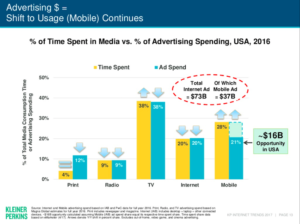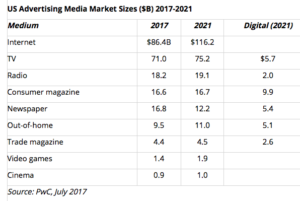Mobile Video Viewing Taking Off in 2017; When Will Advertisers Follow?
Is this the year that advertisers finally catch up with the transformation in mobile video viewing that audiences are driving? More and more studies suggest brands have been way too shy about exploiting their mobile video options, but all I can say is, "What's taking so long?"The latest data points outlining the shift to mobile video viewing come courtesy of Zenith's Online Video Forecasts 2017. The agency, part of giant Publicis, says that mobile video viewing this year will rise more than a third, to nearly 29 minutes a day per person, part of what it says will be an average daily online video diet of 47.4 minutes a day.Importantly, as mobile keeps rising, video views on so-called fixed devices – PCs, laptops and smart TVs – are projected to peak. Zenith still expects such outlets to continue growing, but slowly, at 2 percent for the year to 18.6 minutes per day. And going forward, even as mobile continues grow at a double-digit rate the next two years, fixed devices are projected to decline as more users depend on their mobile device to watch just the videos they want.“Online video is one of the fastest-growing channels of advertising, triggering heavy demand from brands for high-quality content,” said Jonathan Barnard, Head of Forecasting and Director of Global Intelligence at Zenith. “Video platforms that can capture the attention of the most consumers with the best content will reap the highest rewards.” In her 2017 Internet Trends presentation last month, long-time Kleiner Perkins analyst Mary Meeker once again spotlighted the gap between time spent by users on mobile and advertising share devoted to that market.The difference, she said, was a "$16 billion opportunity" for brands who should be trying to reach mobile audiences. Instead, she noted, the continued over-indexing by advertisers on print outlets versus time spent means money misplaced.Zenith notes there are still plenty of advantages in online video for fixed devices, such as larger screens and viewing that typically takes place in less distracting surroundings. Because those larger, quieter platforms deliver brand messages more efficiently, they've still commanding a premium from advertisers.But don't expect that to last.First of all, sites such as Facebook, Twitter, Buzzfeed and Snapchat have signaled they intend to increase the advertising opportunities they'll provide through mobile video. LinkedIn is adding native video capabilities. Sites such as Hulu, Brand.Live, Iris.TV and PadSquad are providing all kinds of opportunities for new kinds of video consumption.Meanwhile, big traditional pay-TV sites such as ESPN and Turner Broadcasting's TNT and TBS are wiring their mobile apps with more and more video capabilities, including live game playback for their pay-TV subscribers. And speaking of live sports, Twitter, Facebook and Amazon are all among the outlets locking up rights to games and highlights.
In her 2017 Internet Trends presentation last month, long-time Kleiner Perkins analyst Mary Meeker once again spotlighted the gap between time spent by users on mobile and advertising share devoted to that market.The difference, she said, was a "$16 billion opportunity" for brands who should be trying to reach mobile audiences. Instead, she noted, the continued over-indexing by advertisers on print outlets versus time spent means money misplaced.Zenith notes there are still plenty of advantages in online video for fixed devices, such as larger screens and viewing that typically takes place in less distracting surroundings. Because those larger, quieter platforms deliver brand messages more efficiently, they've still commanding a premium from advertisers.But don't expect that to last.First of all, sites such as Facebook, Twitter, Buzzfeed and Snapchat have signaled they intend to increase the advertising opportunities they'll provide through mobile video. LinkedIn is adding native video capabilities. Sites such as Hulu, Brand.Live, Iris.TV and PadSquad are providing all kinds of opportunities for new kinds of video consumption.Meanwhile, big traditional pay-TV sites such as ESPN and Turner Broadcasting's TNT and TBS are wiring their mobile apps with more and more video capabilities, including live game playback for their pay-TV subscribers. And speaking of live sports, Twitter, Facebook and Amazon are all among the outlets locking up rights to games and highlights. Don't mistake the online ad world for a side show either.Other data just out from PwC projects that for the first time, online advertising of all kinds this year has overtaken television advertising in terms of spend, and by a lot: $15 billion.By 20121, PwC projects, the online space will be approximately $116 billion a year, 50 percent larger than TV. So there's lots of room here for ad growth on both fixed and mobile sides of online video viewing. Just count on mobile video taking an increasingly large share of that very large pie.Not surprisingly, though, Zenith predicts the disparity between fixed and mobile online video viewing will finally end next year. Simply put, mobile's sheer volume finally catches up, and likely will never look back.A broader and broader range of consumers will see mobile devices as the place they go for a wide array of video-based news, entertainment, education and more. The question, at least in the short term, is who's going to win on mobile while everyone else waits to catch up?
Don't mistake the online ad world for a side show either.Other data just out from PwC projects that for the first time, online advertising of all kinds this year has overtaken television advertising in terms of spend, and by a lot: $15 billion.By 20121, PwC projects, the online space will be approximately $116 billion a year, 50 percent larger than TV. So there's lots of room here for ad growth on both fixed and mobile sides of online video viewing. Just count on mobile video taking an increasingly large share of that very large pie.Not surprisingly, though, Zenith predicts the disparity between fixed and mobile online video viewing will finally end next year. Simply put, mobile's sheer volume finally catches up, and likely will never look back.A broader and broader range of consumers will see mobile devices as the place they go for a wide array of video-based news, entertainment, education and more. The question, at least in the short term, is who's going to win on mobile while everyone else waits to catch up?

